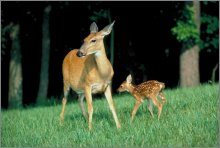Why is the Wild Deer Population Exploding?
(And the Controversial Benefits of Hunting Them)
by www.SixWise.com
In the early 1900s, there were about 500,000 white-tailed
deer in the United States. Today, the number has exploded
to 25 million to 30 million deer nationwide -- a figure that's
close to the amount of deer that were present in 1607 when
settlers landed at Jamestown.
|

There are an estimated 25 million to 30 million deer
throughout the United States.
|
Back then, the abundant deer were a boon to settlers, but
soon their hunting (deer were killed not only for meat but
also for their hides) nearly eradicated the entire population.
That is why, by the early 1900s, the deer population was dangerously
low.
Around this time, states began to limit hunting and open
space began being preserved (as opposed to all of it being
cleared for agriculture). In just a few decades, about 30
states had not only revived their deer populations, they had
too many of them.
And the population has continued growing, largely because
deer's natural predators, wolves, are sparse and hunting has
been on the decline. Whereas deer population in pre-European
settlement times was about 10 or 15 deer per square mile,
today some areas have 30 or 35 deer per square mile.
"In some ways we've been too successful at bringing
the deer back," said Paul Curtis, an associate professor
and extension wildlife specialist at Cornell University.
Problems with Too Many Deer
A deer population that rises out of control has the potential
to harm in a number of ways. Most directly is through an increase
in deer-automobile collisions. According to the Insurance
Institute for Highway Safety, some 1.5 million vehicles collided
with deer in 2003, causing nearly 14,000 injuries and over
$1 billion in vehicle damage.
Meanwhile, an overabundance of deer could threaten forests,
and therefore other wildlife, across the country. According
to one study, wild American ginseng and other forest-floor
plants are in danger of going extinct because white-tailed
deer eat them faster than they grow back. Another favorite
food of deer, saplings, is also being eaten in devastating
amounts.
|

Many states are now expanding hunting seasons and increasing
bag limits to cull deer herds.
|
"There are no saplings, no underbrush for ground nesting
birds," said Richard Parker, regional director of the
Genesee State Park Region. "There will be no regeneration
of the forest. In 40 to 50 years, as the current forest dies,
there will be nothing to replace it."
Deer Management Programs Draw Controversy
Many states have begun implementing deer management programs
to thin out deer populations. The most controversial are those
that involve killing increasing numbers of deer, such as:
-
Hiring sharp shooters to cull deer herds
-
Expanding hunting seasons
-
Encouraging the hunting of female deer
-
Increasing hunters' bag limits
While thinning out deer populations, the increased deer kills
have also supported the Farmers
and Hunters Feeding the Hungry (FHFH) program, which is
now active in over 25 states. FHFH has donated 1,600 tons
of venison and other big game to soup kitchens and food pantries
across the United States to help feed the hungry.
However, public opinion tends to look unfavorably on these
types of deer management plans. While hunters don't want an
excess of deer killed because the large population increases
their chances of a kill, animal rights groups and non-hunters
call for a more humane method of control, such as relocation
or even contraception.
For deer problems hitting closer to home, such as in your
backyard or garden, the United States Humane Society recommends
the following humane methods to keep deer away:
-
Install an 8- to 10-foot tall, vertical, woven-wire fence
-
Hanging bars of deodorant soap (with wrappers intact)
near the problem area
-
Hanging excrement from dogs or cats in cloth bags near
the area
-
Scare devices, particularly those that are motion-activated
and, when activated, play a loud noise, spray water, or
turn on a bright light
Recommended Reading
Five
of America's Most Dangerous Wild Animals -- How to Beware!
The
5 Great National Parks Almost No One Knows About
Sources
MSNBC.com
EurekAlert
Discover.com
The
Humane Society of the United States